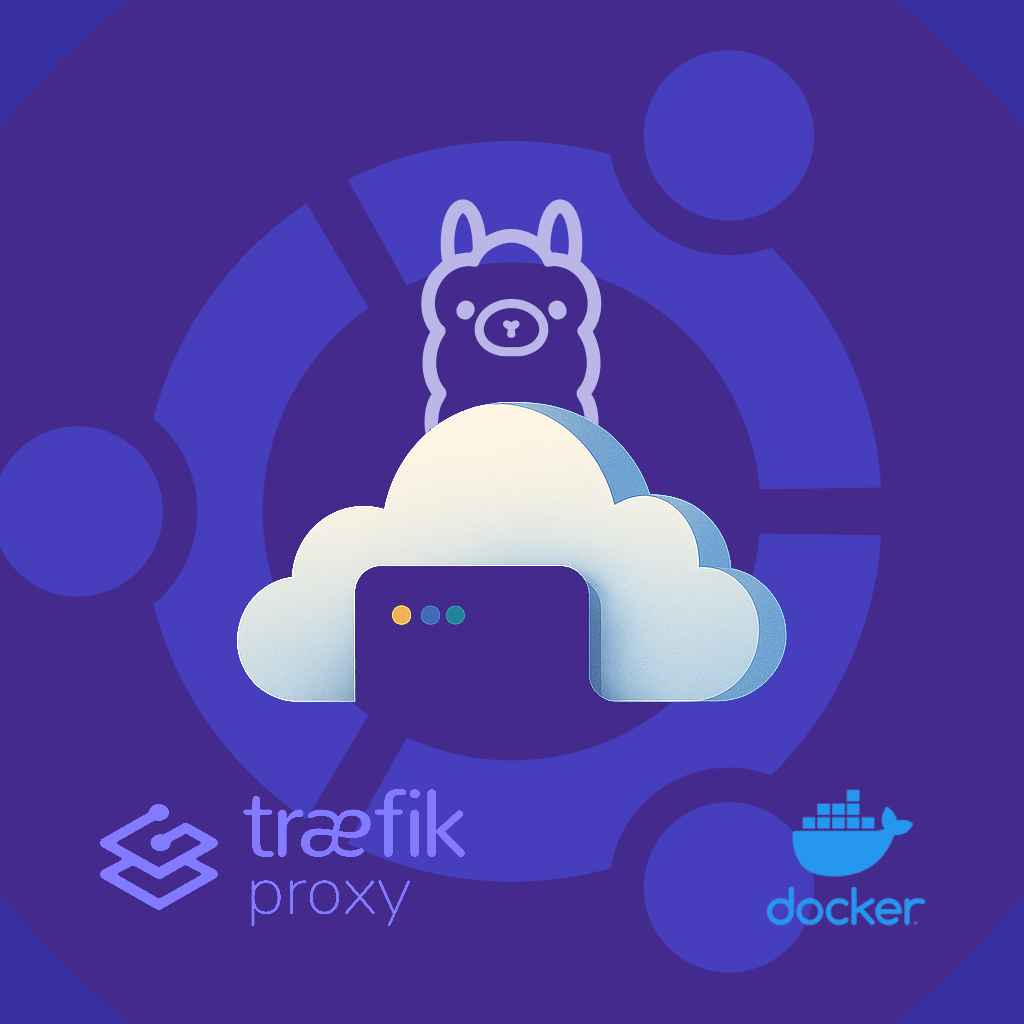
Setting up and running your own LLM server is actually easier than you might think. All you need is a VPS running on the cloud and Ubuntu Linux.

You need to create a new VPS instance with a cloud provider that fits your budget. For better results, your virtual machine should ideally have GPU (Graphics Processing Unit) support, but for simple experiments, you can still run models that only use the CPU.
For simple experiments, you can use an instance with at least 8 CPUs and 32 GB of RAM. Installing Ollama is not difficult at all. Normally, you can install it on your machine via a simple CLI command like;
curl -fsSL https://ollama.com/install.sh | sh
however, by placing a traefik load balancer in front, you can serve
it securely over HTTPS. So, before going further, let’s install docker
to our VPS.
First, set up Docker’s apt repository:
# Add Docker's official GPG key:
sudo apt-get update
sudo apt-get install ca-certificates curl
sudo install -m 0755 -d /etc/apt/keyrings
sudo curl -fsSL https://download.docker.com/linux/ubuntu/gpg -o /etc/apt/keyrings/docker.asc
sudo chmod a+r /etc/apt/keyrings/docker.asc
# Add the repository to Apt sources:
echo \
"deb [arch=$(dpkg --print-architecture) signed-by=/etc/apt/keyrings/docker.asc] https://download.docker.com/linux/ubuntu \
$(. /etc/os-release && echo "${UBUNTU_CODENAME:-$VERSION_CODENAME}") stable" | \
sudo tee /etc/apt/sources.list.d/docker.list > /dev/null
sudo apt-get update
Then, install the Docker packages:
sudo apt-get install docker-ce docker-ce-cli containerd.io docker-buildx-plugin docker-compose-plugin
You should see when;
sudo docker ps
CONTAINER ID IMAGE COMMAND CREATED STATUS PORTS NAMES
Then, verify that the installation is successful by running the hello-world
image:
sudo docker run hello-world
If you don’t see the docker ps result:
sudo systemctl enable docker
Now, add your current (logged in) user to docker group:
sudo usermod -aG docker "${USER}"
You can now reboot your server and use docker w/o sudo:
sudo reboot
After reboot, re-connect and check:
docker ps
Before going further, you must tweak some firewall rules:
sudo ufw status
Status: active
To Action From
-- ------ ----
OpenSSH ALLOW Anywhere
443 ALLOW Anywhere
80 ALLOW Anywhere
OpenSSH (v6) ALLOW Anywhere (v6)
443 (v6) ALLOW Anywhere (v6)
80 (v6) ALLOW Anywhere (v6)
If you don’t see like this, now allow:
sudo ufw allow 443
sudo ufw allow 80
sudo ufw status # re-check
Now, let’s create a network for our services:
docker network create traefik_net
Now, point your A DNS record to your vps, also you can point *.myollama.com as CNAME DNS record too. We’ll use myollama.com as an example domain, set your’s instead of that.
Now, you have docker up and running, let’s add some services:
nano docker-compose.yml
Here is you yaml file:
services:
traefik:
image: traefik:v3.2
container_name: traefik
networks:
- traefik_net
command:
- "--providers.docker"
- "--providers.docker.watch=true"
- "--entrypoints.web.address=:80"
- "--entrypoints.web.forwardedheaders.insecure=true"
- "--entrypoints.websecure.address=:443"
- "--entrypoints.websecure.forwardedheaders.insecure=true"
- "--entrypoints.web.transport.respondingTimeouts.readTimeout=3600s"
- "--entrypoints.web.transport.respondingTimeouts.idleTimeout=3600s"
- "--entrypoints.websecure.transport.respondingTimeouts.readTimeout=3600s"
- "--entrypoints.websecure.transport.respondingTimeouts.idleTimeout=3600s"
- "--certificatesresolvers.myollama.acme.tlschallenge=true"
- "--certificatesresolvers.myollama.acme.email=your@email" # set yours here...
- "--certificatesresolvers.myollama.acme.storage=/letsencrypt/acme.json"
- "--api.dashboard=true"
- "--api.insecure=false"
- "--log.level=INFO"
labels:
- "traefik.enable=true"
- "traefik.http.routers.traefikdashboard.rule=Host(`traefik.myollama.com`)"
- "traefik.http.routers.traefikdashboard.entrypoints=websecure"
- "traefik.http.routers.traefikdashboard.tls=true"
- "traefik.http.routers.traefikdashboard.tls.certresolver=myollama"
- "traefik.http.routers.traefikdashboard.service=api@internal"
ports:
- target: 80
published: 80
protocol: tcp
mode: host
- target: 443
published: 443
protocol: tcp
mode: host
- "8080:8080"
volumes:
- /var/run/docker.sock:/var/run/docker.sock
- letsencrypt_data:/letsencrypt
ollama:
image: ollama/ollama
container_name: ollama
restart: always
volumes:
- ollama:/root/.ollama
networks:
- traefik_net
environment:
OLLAMA_HOST: "0.0.0.0"
labels:
- "traefik.enable=true"
- "traefik.docker.network=traefik_net"
- "traefik.http.routers.ollama.rule=Host(`ollama.myollama.com`) && PathPrefix(`/api`)"
- "traefik.http.routers.ollama.entrypoints=websecure"
- "traefik.http.routers.ollama.tls=true"
- "traefik.http.routers.ollama.tls.certresolver=myollama"
- "traefik.http.services.ollama.loadbalancer.server.port=11434"
volumes:
letsencrypt_data:
driver: local
ollama:
external: true
networks:
traefik_net:
external: true
To test you infrastructure, run:
docker compose up
Now, you should open the traefik’s admin page:
https://traefik.myollama.com
If you see the traefik admin panel, this means all look good. Before hitting CTRL + C, try to make an api-call to your ollama:
curl https://ollama.myollama.com/api/tags
You should see an empty list. Ollama has many free models, check here.
Now, let’s add llama3.2:
curl https://ollama.myollama.com/api/pull \
-X POST \
-H "Content-Type: application/json" \
-d '{"name": "llama3.2"}'
Verify your models list again:
curl https://ollama.myollama.com/api/tags
Now, let’s ask some questions:
curl https://ollama.myollama.com/api/generate -d '{
"model": "llama3.2",
"prompt": "Do you know Commodore 64?"
}'
You should see the streaming response:
{"model":"llama3.2","created_at":"2025-04-28T17:57:02.009341093Z","response":"The","done":false}
{"model":"llama3.2","created_at":"2025-04-28T17:57:02.066937138Z","response":" Commod","done":false}
{"model":"llama3.2","created_at":"2025-04-28T17:57:02.129586007Z","response":"ore","done":false}
{"model":"llama3.2","created_at":"2025-04-28T17:57:02.185728788Z","response":" ","done":false}
{"model":"llama3.2","created_at":"2025-04-28T17:57:02.243180793Z","response":"64","done":false}
{"model":"llama3.2","created_at":"2025-04-28T17:57:02.300290398Z","response":"!","done":false}
{"model":"llama3.2","created_at":"2025-04-28T17:57:02.361670982Z","response":" Yes","done":false}
{"model":"llama3.2","created_at":"2025-04-28T17:57:02.420431671Z","response":",","done":false}
{"model":"llama3.2","created_at":"2025-04-28T17:57:02.479269069Z","response":" I","done":false}
{"model":"llama3.2","created_at":"2025-04-28T17:57:02.534692399Z","response":" do","done":false}
{"model":"llama3.2","created_at":"2025-04-28T17:57:02.590992232Z","response":".","done":false}
{"model":"llama3.2","created_at":"2025-04-28T17:57:02.648129077Z","response":" The","done":false}
{"model":"llama3.2","created_at":"2025-04-28T17:57:02.70492895Z","response":" Commod","done":false}
{"model":"llama3.2","created_at":"2025-04-28T17:57:02.76015093Z","response":"ore","done":false}
:
:
{"model":"llama3.2","created_at":"2025-04-28T17:57:20.810774225Z","response":"","done":true,"done_reason":"stop","context":[128006,9125,128007,.....,30],"total_duration":21537524622,"load_duration":2029325408,"prompt_eval_count":33,"prompt_eval_duration":703136354,"eval_count":323,"eval_duration":18803717677}
Yes, you have your own LLM running on your private VPS! Now, you can exit via
hitting CTRL + C and improve your docker-compose.yml
for more private access.
You can limit/restrict access with load balancer. You can allow some special IPs or enable CORS for desired domains:
Allow only these IP addresses 92.45.1XX.1YY and 78.19X.2XX.YY and allow
only these domains *.ngrok.app and mycustomollama.com domain for CORS:
services:
traefik:
image: traefik:v3.2
container_name: traefik
networks:
- traefik_net
command:
- "--providers.docker"
- "--providers.docker.watch=true"
- "--entrypoints.web.address=:80"
- "--entrypoints.web.forwardedheaders.insecure=true"
- "--entrypoints.websecure.address=:443"
- "--entrypoints.websecure.forwardedheaders.insecure=true"
- "--entrypoints.web.transport.respondingTimeouts.readTimeout=3600s"
- "--entrypoints.web.transport.respondingTimeouts.idleTimeout=3600s"
- "--entrypoints.websecure.transport.respondingTimeouts.readTimeout=3600s"
- "--entrypoints.websecure.transport.respondingTimeouts.idleTimeout=3600s"
- "--certificatesresolvers.myollama.acme.tlschallenge=true"
- "--certificatesresolvers.myollama.acme.email=your@email" # set yours here...
- "--certificatesresolvers.myollama.acme.storage=/letsencrypt/acme.json"
- "--api.dashboard=true"
- "--api.insecure=false"
- "--log.level=INFO"
labels:
- "traefik.enable=true"
- "traefik.http.routers.traefikdashboard.rule=Host(`traefik.myollama.com`) && (ClientIP(`92.45.1XX.1YY`) || ClientIP(`78.19X.2XX.YY`))"
- "traefik.http.routers.traefikdashboard.entrypoints=websecure"
- "traefik.http.routers.traefikdashboard.tls=true"
- "traefik.http.routers.traefikdashboard.tls.certresolver=myollama"
- "traefik.http.routers.traefikdashboard.service=api@internal"
ports:
- target: 80
published: 80
protocol: tcp
mode: host
- target: 443
published: 443
protocol: tcp
mode: host
- "8080:8080"
volumes:
- /var/run/docker.sock:/var/run/docker.sock
- letsencrypt_data:/letsencrypt
ollama:
image: ollama/ollama
container_name: ollama
restart: always
volumes:
- ollama:/root/.ollama
networks:
- traefik_net
environment:
OLLAMA_HOST: "0.0.0.0"
OLLAMA_ORIGINS: "https://*.ngrok.app,https://mycustomollama.com,http://localhost,https://localhost,http://localhost:*,https://localhost:*,http://127.0.0.1,https://127.0.0.1,http://127.0.0.1:*,https://127.0.0.1:*,http://0.0.0.0,https://0.0.0.0,http://0.0.0.0:*,https://0.0.0.0:*,app://*,file://*,tauri://*,vscode-webview://*,vscode-file://*"
labels:
- "traefik.enable=true"
- "traefik.docker.network=traefik_net"
- "traefik.http.routers.ollama.rule=Host(`ollama.myollama.com`) && PathPrefix(`/api`) && (ClientIP(`92.45.1XX.1YY`) || ClientIP(`78.19X.2XX.YY`))"
- "traefik.http.routers.ollama.entrypoints=websecure"
- "traefik.http.routers.ollama.tls=true"
- "traefik.http.routers.ollama.tls.certresolver=myollama"
- "traefik.http.services.ollama.loadbalancer.server.port=11434"
volumes:
letsencrypt_data:
driver: local
ollama:
external: true
networks:
traefik_net:
external: true
Test you configuration via docker compose up, make sure you can access the
traefik admin panel, and api. Great ha? now, let’s add these docker compose up
command to your system’s startup, incase of reboot or crash, your ollama
will start automatically.
Create a file in: ~/traefik-ollama.service on your VPS, assuming your logged
in user is ubuntu user:
[Unit]
Description=Traefik + Ollama stack
After=docker.service
Requires=docker.service
[Service]
Type=oneshot
WorkingDirectory=/home/ubuntu/
ExecStart=/usr/bin/docker compose up -d
ExecStop=/usr/bin/docker compose down
RemainAfterExit=yes
[Install]
WantedBy=multi-user.target
Now, link this file to:
sudo ln -s /home/ubuntu/traefik-ollama.service /etc/systemd/system/
Now, enable:
sudo systemctl daemon-reload
sudo systemctl enable traefik-ollama.service
sudo systemctl start traefik-ollama.service
Now, reboot your vps and check if the system is auto started? Visit, ollama’s api documentaion page for more functionality.